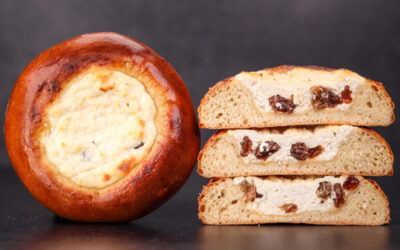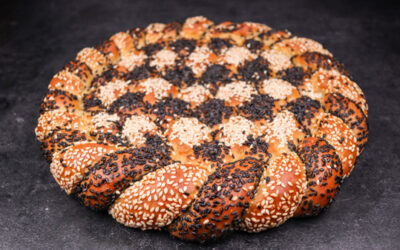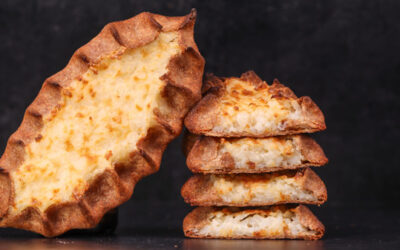I grew up in Latvia as many of you will know. But I have not featured many Latvian breads here yet. These cured pork and onion filled dumplings will be the perfect introduction.
Speķa pīrāgi literally translate to fat pies. It is because we call the salt cured and smoked pork belly ‘fat’. It does not meat that it is 100% fat though. You can get pieces that are leaner or fattier. For the purposes of this recipe, I would look for a 50/50 ratio of fat and lean meat, but whatever you can get your hands on will be good to go.
These bacon dumplings are some of my favourite snacks from back home. And they are very popular over there. There are other variants too like ones filled with cabbage and onions or even cottage cheese and raisins. I might make videos about them in the future.
Simplicity is key here. The filling contains only three ingredients – cured and smoked pork, onions, and black pepper. Try and seek out the real stuff. You want a piece of pork belly that looks like it’s been smoked in an old barn in the countryside. Unfortunately, it is the kind of meat not commonly sold in supermarkets.
There are alternatives of course. You can use cured and cooked ready to eat pork from the deli counter. Even pancetta may work. Look for smoked and fatty pork.
Fresh onions and plenty of freshly ground black pepper balance and elevate the intense saltiness and smokiness of the pork.
The dough is an enriched white bread dough which is just a soft vessel for the delicious filling.
This recipe makes 16 bacon patties.
Watch the video down below for detailed instructions.
Ingredients
For the dough –
250g (8.8oz) white bread flour
3g (0.1oz) instant dry yeast or 3.6g (0.12oz) active dry yeast or 9g (0.31oz) fresh yeast
5g (0.17oz) salt
20g (0.7oz) sugar
50g (1.75oz) softened butter
130g (4.6oz) cold milk*
*To learn more about dough temperature control click here.
1 egg for glazing
For the filling –
200g (7oz) cured smoked pork belly, finely diced
120g (4.25oz) fresh white onion, finely diced
3g (0.1oz) freshly ground black pepper
The flour I use has a protein content of 13%. If your flour is weaker, then you may need to lower the hydration.
If you are using active dry yeast, then you may need to let it sit in the water for 10 minutes before adding the other ingredients or else it could take a lot longer to raise the dough.
If you are curious about why the dough contains butter and sugar, click the links to learn more about the effects those ingredients have on bread dough.
Method
- Make the filling. Mix all the ingredients and leave on the side. I like to keep this at room temperature for three reasons. One is that the juices and flavours of the pork and onions will get to mingle. Second is that a cold filling can slow the final fermentation, so keeping it at room temperature will prevent that. And third is that at room temperature it is a lot easier to wrap this filling into the dough as it is softer and easier to handle.
- Make the dough. In a large bowl combine the milk, yeast, salt, sugar, and butter. Mix well to dissolve the salt and sugar and to hydrate the yeast. Add the flour and mix to a dough.
- Tip the dough out on the table and knead for 4 minutes. *Desired dough temperature around 25C (77F). If your dough is warmer, then it will ferment more rapidly. If it is cooler, then it will take longer. Adjust proofing time accordingly.
- Cover and ferment for 2 hours.
- Divide the dough into 16 equal pieces and shape into balls.
- Cover and leave to rest for 15 minutes.
- Fill the dough balls with the pork and onion mix and shape them into patties. *See video.
- Place on a non-stick paper lined tray. Cover and final proof for 1.5 hours. *During this time preheat your oven to 230C (445F) fan off.
- Brush the patties with egg, leave them to dry for 5 minutes and brush them again.
- Bake for 12 minutes.
- Leave to cool down slightly and enjoy with a cold beer or refreshing beverage of your choice.
Keep in mind that the conditions in each kitchen are different, so fermentation times may vary for you. It is up to the baker to control the bread and react accordingly.
Your oven may be different too, so your baking time may vary.
Watch the video here



